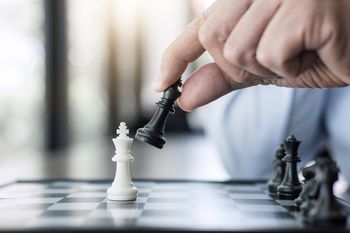"Buy and hold" is a popular stance amongst many investors who prefer to hold their investments for the long term and not give in to the short term fluctuations in the market. The strategy certainly works as it prioritises long term stability over short term profit. Many well-known investors have proven the strategy's ability to yield consistent returns.
In this article, we look at the "buy and hold" investment strategy and answer the following questions:
- What is buy and hold strategy?
- How does the buy and hold strategy work?
- Pros and cons of the buy and hold strategy.
What is buy and hold strategy?
"Buy and hold" is a popular investing strategy in which an investor chooses his financial assets (stocks, bonds, or real estate) and holds them for the long term without reacting to market swings. It is a passive investment strategy where the investor forgoes short term volatility and gains to keep a stable portfolio. This strategy is well-received because it works and has shown to outperform other investment methods on average. Many well-known investors have tried and succeeded through buying and holding.
Definition of the buy and hold strategy
Buy and hold involves an investor buying financial or non-financial assets with the intention of reaping a price increase despite market instability. The basic principle behind buy and hold investing is to stay involved throughout market cycles, as missing a few of the finest days can have a significant influence on your long-term profits.
The logic behind this strategy stems from the fact that investments, no longer how risky it is, is more likely to generate consistently higher returns because of compounding. And markets are known to go up rather than down. Of course, investors must adhere to the buy and hold strategy with a certain kind of mindset. Investors must buy those expected to exceed in value in the long term and not sell when the prices fall. Investors must refrain from market timing because that is not their investment goal.
How does the buy and hold strategy work?
The buy and hold strategy is straightforward. You simply need to choose the assets you want to invest in and after purchasing it, you hold it for years. Buying and holding is typically a long term strategy. However, the amount of time you keep, depends on your financial goals. If you buy and hold stock for your retirement fund, for example, you could keep them for decades until you decide to retire. If you buy and hold real estate, you may decide to sell it after the market price rises or you can keep it to pass it over to your children.
The Efficient Market Hypothesis[1] supports passive investment through buying and holding. According to this hypothesis, all known information regarding investment securities has already been included into the price. This theory also states that an investor who is trying to beat the market through research and knowledge will not be more effective than an investor who is simply utilising buy and hold strategy.
However, not all buy and hold investors agree with this theory. Value investing is also aligned with buy and hold. Fundamental analysis is frequently used by value investors. They will look for stocks in companies where the price is lower than the actual value of the company. Investors will buy it and keep it until either the stock's price rises to the point where it is worth more than the company, or the company's business model changes, lowering its value. Based on the outcome, the investor may keep it or sell it.
So how to calculate buy and hold return? You can only calculate your returns after you have sold the investment. You will be able to evaluate how much you paid for it to how much you sold it for.
Examples of the buy and hold strategy
There are no examples of ultimate buy and hold portfolio strategy. Your buy and hold strategy would depend on what kind of asset class you are investing in. If you invest in equities, then your buy and hold strategy would be to buy low and sell high. If you choose bonds, your buy and hold bond strategy would be based on the belief that bonds are a dependable source of income. The bonds' cash flow can be used to cover external income needs or reinvested in the portfolio to buy more bonds or diversify into other asset classes. If you choose to buy properties, your buy and hold real estate strategy would be to produce rental income and grow wealth over time, refinance, or sell when the time is appropriate. Another buy and hold strategy real estate investing would be to use a cash-out refinance to take equity out of one home and use it to purchase another instead of selling it.
Pros and cons of the buy and hold strategy
The theory behind buy-and-hold investing is that you will eventually be rewarded for taking on additional risk, but only if you stick to your guns and stay the course. Despite the evidence in favour of buy-and-hold investing, many investors find it difficult to sit back and wait for their investments to grow. This is due to the anxiety and pain that come with a higher level of investing risk, which many investors fear. During times of market volatility, a prudent buy and hold strategy can suddenly morph into an active trading approach. This can result in you not only buying and selling at inopportune times, but also increasing your investment costs due to trading commissions. Also, there are no assurances that the buy and hold strategy will not lose you any money at all. Yet, there are good reasons why buy and hold can be beneficial.
What are the advantages of the buy and hold strategy?
Buy and hold investment strategy has a considerable number of benefits for the investor. Hence, many investors put their faith in it despite recognising that the growth will be slower. Equity holders, mostly, value their investments because they have ownership of the asset of the equity, and ownership is not to be treated as a short term tool. The following are the most common buy and hold strategy advantages:
- Higher returns: Buy and hold investing has generated 9.9% for large caps and 12.1% for small caps on average, despite decades of financial turmoil. This is simply due to compounding, where, over a long period, investments, especially equities, generate a high ROI
- Taxes: Buying and holding enables investors to get a favourable rate on capital gains taxes. Since capital gains are only taxed after the investment is sold, long term investments will allow investors to delay it until it is sold. This is not possible for short term investments because investors will sell their holdings multiple times, and therefore, investors will pay more in taxes
- Reduced costs: Much like taxes, selling and buying constantly incur transaction costs, and the more you trade, the more you spend on the fees. Buy and hold favours investors in terms of lowering those costs as there will be fewer trades
What are the drawbacks of the buy and hold strategy?
Buy and hold risks are not talked about enough. Despite generating good results on average, buy and hold should not be treated as a superior method to others. Granted, studies have shown consistent, stable buy and hold returns, but it only supports investors whose goals are aligned with the strategy. As such, there are a few disadvantages of buy and hold strategy that investors should consider:
- It is time consuming: It takes a lot of time to reap the benefits of buy and hold. Even after a decade, you may not be able to receive the reward that you expected. A good example is that of utility stocks, which have since been stagnant in growth. While not risky, there are opportunities that the investor is missing, which he can simply mitigate by diversifying between short term and long term instruments or trading index funds
- Not immune to losses: Just because an investor expects the investment to go up in value does not mean it will. Investors can pick investments that will lose significantly over time. This is perhaps the largest risk attached to the buy and hold strategy
- Not immune to fluctuations: Long term investment does not ensure that your assets will not face fluctuations. Although the fluctuations will remain for a short period, the overall value may increase significantly or decrease even if you do not incur major losses
- Restricted liquidity: By choosing to buy and hold, you are giving up your access to cash. Since the money is in it for the long haul, you will be unable to withdraw whenever necessary. Therefore, investors need to set aside liquid funds before making investments to ensure that they have access to funds during emergencies
- Discipline: To buy and hold means you are in it for the long term, and that means you cannot seek other opportunities around it. Even when you see short term profits, you have to force yourself to adhere to the strategy simply because your goal is long-term. In practice, this is difficult, especially when you see no growth or, worse, losses
- Missed opportunity: Since investors' goals are to hold their investments for the long term, they are forgoing profits from short-term trading. While it works, investors often miss optimal times when they could have sold to reap the benefits simply because they feel that the value will increase more in the future. Again, while the belief is valid, it is still propagated by emotions, biases, and general aversion to risk. There are plenty of investors who profit regularly from short term trading. Successful investment does not mean holding on to your investment for a long time. It also means yielding results
Summary
"Buy and hold" is a common approach in which you invest for the long term rather than reacting to short-term market changes. Long-term stability is prioritised over short-term profit in this strategy. Buy and hold techniques can be used in shares, bonds, real estate, and a variety of other asset classes. While it has advantages, it also has disadvantages. Higher returns, tax savings, and lower costs are some of the perks. The disadvantages of buy and hold strategies are that they are time-consuming, that you may lack the discipline to not succumb to fear and sell your assets when they are not performing well, and that they are not immune to losses or swings.
Like any investor or trader, buying and holding require a sound risk management strategy to be implemented. The investor must be willing to put a stop to the investment before the losses compound. Buy and hold remains the preferred strategy and is proven in the market since it costs little, it is passive, and it does not require timing the market. However, investors are still missing out on opportunity costs and could potentially be inviting losses by betting on their growth expectations.
Frequently Asked Questions
What does the buy and hold investment strategy mean in practice?
The buy and hold strategy means purchasing assets such as stocks, bonds, or real estate and keeping them for the long term, regardless of short-term price fluctuations. It focuses on compounding growth and long-term stability rather than market timing.
Is buy and hold a good strategy for investors in Europe?
Yes, buy and hold can be an effective approach for European investors, especially in equities and real estate. However, it requires patience, discipline, and a long-term financial horizon to withstand market volatility and delayed returns.
What are the main risks of using the buy and hold strategy?
The key risks include lack of liquidity, exposure to long market downturns, missed opportunities from short-term trading, and the psychological challenge of holding during downturns. Investors also face the possibility of choosing assets that underperform even in the long run.
List of References
- Source: www.thebalancemoney.com






